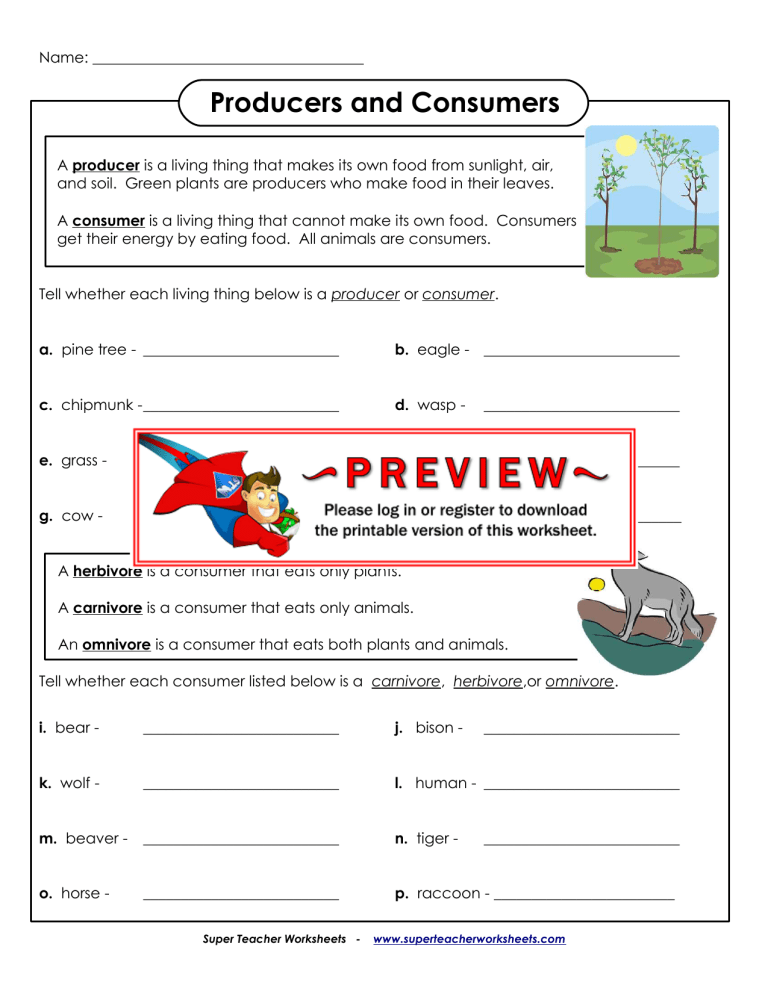Besides pollinating your crops, wasps provide many other environmental benefits. In general, wasps are considered to be beneficial insects because they consume large quantities of pests insects such as caterpillars, grasshoppers, and beetles. They also eat bedbugs, cockroaches, and many other insect pests that can damage your crops. It is believed a single colony of wasps will consume approximately 5000 pest insects in a lifetime. Wasps may sometimes be seen hovering around flowers where they feed on nectar by sucking it from the surface of the flower.
Every person, plant, or animal needs to take in energy to live and grow. This process is going on around all the time. For example, grass grows on a prairie. It is a producer and makes its food from the sun. The grass is consumed by the rabbit, which is a consumer and needs to eat something to obtain its energy. The rabbit is then eaten by a coyote, also a consumer. When the coyote dies, it is eaten and decomposed by worms and bacteria, which are decomposers, returning its nutrients into the food chain to be used again. Many different food chains interconnect, forming complex food webs in ecosystems.
What is a Producer in an Ecosystem?
At the base level in all food, chains are the producers. Producers are also called autotrophs. Auto means self, while troph means food. They are organisms that create their food from inorganic molecules such as water, CO2, nitrogen, and phosphate. Most producers get their energy from the sun, which they use to change the inorganic molecules into complex carbohydrates like sugars and starches, which are used for food. Producers are the base or first level in all food chains. There are many more producers in a food chain than consumers or decomposers because only 10% of the energy from each energy level is passed on to the next energy level.
Examples of Producers in an Ecosystem
Producers are organisms that can make their food, such as trees, shrubs, grass, algae, lichen, seaweed, and some bacteria. All of these are green in color because they contain chlorophyll that absorbs the energy from the sun and uses it to produce food. This is known as photosynthesis. The only exception to this rule is some bacteria that live deep within the ocean, further than sunlight can reach, use certain kinds of chemicals to produce their energy. That is known as chemosynthesis. Algae, including many types of seaweed, are the primary producers of most aquatic ecosystems. In Arctic ecosystems, lichens are the primary producers.
An example of a producer in an ecosystem is grass which produces its food. The grass is eaten by a caterpillar, who is eaten by a bird, which is eaten by a cat and is later eaten by bacteria upon its death.
What is a Consumer in an Ecosystem?
A consumer in an ecosystem is an organism that does not produce its food but must eat other organisms to obtain energy. Consumers are also called heterotrophs. Hetero means same, and troph means food. In the food chain, a consumer can be at the second, third, fourth, or even higher energy levels. Remember, as energy goes up the food chain, only around 10% is passed up to the next level.
Consumers fall into three groups: herbivores, carnivores, and omnivores. Herbivores are animals or insects that only eat plants. Carnivores are animals are insects that eat only other animals, and omnivores are animals or insects that eat both plants and animals.
Examples of Consumers in an Ecosystem
Consumers can include mammals, birds, fish, reptiles, amphibians, insects, fungi, and some types of bacteria. Examples of herbivores are rabbits, dears, cows, elephants, sheep, and many fish. They are considered a first-level consumer because they can not produce their food, but they eat only plants. Carnivores include lions, tigers, snakes, sharks, spiders, and sea stars. All of these animals eat only meat and can be second, third, fourth, or higher-level consumers. An omnivore is an animal that eats both plants and animals. Some examples of this would be bears, dogs, raccoons, insects, and people. These also can be second, third, fourth, or more levels of consumers. Some people who are vegetarians would be considered herbivores.
An example of an aquatic food chain with lots of consumers would be phytoplankton, which is eaten by zooplankton, which is eaten by crabs and is eaten by fish, which are eaten by sharks, which are eaten by humans who are eaten by bacteria upon death. The zooplankton, crabs, fish, sharks, and people are all consumers within this food chain.
Is A Wasp A Consumer Or Producer
A wasp is a consumer. It consumes smaller insects, which it catches with its long tongue and stings to paralyze them. When it has captured its prey, the wasp lays an egg on its body and then places the insect in a nest of wood pulp that it has built. As the young wasps hatch from their eggs, they feed on their paralyzed prey. Wasps are known as beneficial insects because they help control harmful pests such as flies and cockroaches. They also pollinate flowers, which helps plants grow better.
A wasp eats other insects, which it hunts and kills using its sting, which injects venom into the prey. This venom paralyzes the insect’s muscles, allowing the wasp to carry it back to its nest. Once there, the wasp lays an egg in the insect’s body and seals it inside. The wasp larva feeds on its living host until it emerges as an adult wasp.
